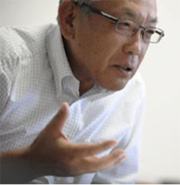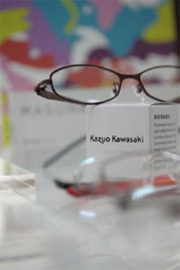Home > Highlighting JAPAN > Highlighting Japan OCTOBER 2011 > The Farsighted Vision of Masunaga Optical
Highlighting JAPAN
JAPAN BRAND
The Farsighted Vision of Masunaga Optical
Gavin Blair visits innovative high-end spectacles manufacturer Masunaga Optical in Fukui Prefecture.

Masunaga Optical President Satoru Masunaga
Credit: ALFIE GOODRICH
As well as founding Masunaga Optical, his own company, Masunaga helped groups of newly trained craftsmen start out on their own, eventually leading to hundreds of businesses springing up across the local area.

A pair of the Masunaga glasses presented to the Showa Emperor on his visit to Fukui in 1933 and which the company re-released in a special edition to celebrate the centenary of its founding in 2005.
Credit: ALFIE GOODRICH
While many companies came and went, some unable to survive the arrival in the marketplace of cheaper glasses from other Asian countries, Masunaga Optical is still going strong as a manufacturer of high-end glasses.
The company began exporting glasses to Asia before World War II, and afterwards to Europe and the United States. However, the image of Japanese goods at that time was still "cheap" and "poor quality," explains Masunaga.
"Now we get complaints from our distributors that our glasses last for too long. They say 'sales of lenses are up but sales of frames are down, because customers keep replacing the lenses in the same frames.' They say we should make frames that aren't so durable. I think they're only half joking," says Masunaga with a laugh.
Some 50% of the company's sales are now made overseas, and Masunaga Optical's profile was raised even further when it was widely reported that the distinctive frames worn by U.S. vice-presidential candidate Sarah Palin during the 2008 election campaign were made by the company. Although the Masunaga brand name received a global boost, it actually cost the company money in the short-term.
"We used to sell about 5,000 pairs a year of the Kazuo Kawasaki model that Palin wore. Soon after all the media started talking about her glasses, we got orders for 100,000 pairs. And we only had 70 in stock at the time," recalls Masunaga.
"We switched all our production over to that model and stopped making everything else. The margins are lower on our exports; in addition, we upset customers who received their deliveries late. In the end, we would have made more money had we carried on as normal," says Masunaga, while acknowledging the episode was great advertising for the company.

Frames in the Kazuo Kawasaki line are designed based on "human engineering," in collaboration with the distinguished industrial designer Kazuo Kawasaki. The frames won the Good Design Prize in 2001.
Credit: ALFIE GOODRICH
Future Glasses
Masunaga Optical has also developed various innovative pieces of eyewear that the president calls "future glasses." These include Wink Glasses that cloud over if the wearer doesn't blink regularly—a common problem that leads to dry and tired eyes for people using computer screens all day. Another invention developed by the company is super-strength glasses with a camera-like lens built-in for people who are close to blind. While these Eye Fine glasses are a prototype that still requires work on the focus mechanism, Masunaga is confident that one day the technology will be perfected.
Meanwhile the firm's Teleglass spectacles serve as a wearable monitor that can display video or other images, these being created years before major electronics companies brought the technology to market. These futuristic glasses were created in 2005 as part of a collection to mark the 100th anniversary of the company's founding. Masunaga Optical also celebrated its past by issuing a special replica model of the glasses that the company had made for the Showa Emperor in the 1930s. The distinctive round frames were a hit and the entire production run sold out despite the very high price tag. Masunaga proudly keeps a set of the 1930s originals in his office.
Currently in the pipeline are glasses that can display information across the lenses when required, a feature that Masunaga believes may be used by doctors performing operations, as well as many other potential applications. All the while, the company continues to upgrade the quality of its frames, largely through hands-on creation processes pursued by highly qualified engineers.
Masunaga says that almost all of the company's models get copied in one way or another, whether by low-cost manufacturers in other countries replicating their designs, or by technology companies taking ideas from their "future glasses."
"Our products are always getting imitated and replicated, but it's OK, because nobody can really copy our craftsmanship and know-how," he says with a confident smile.
© 2009 Cabinet Office, Government of Japan






